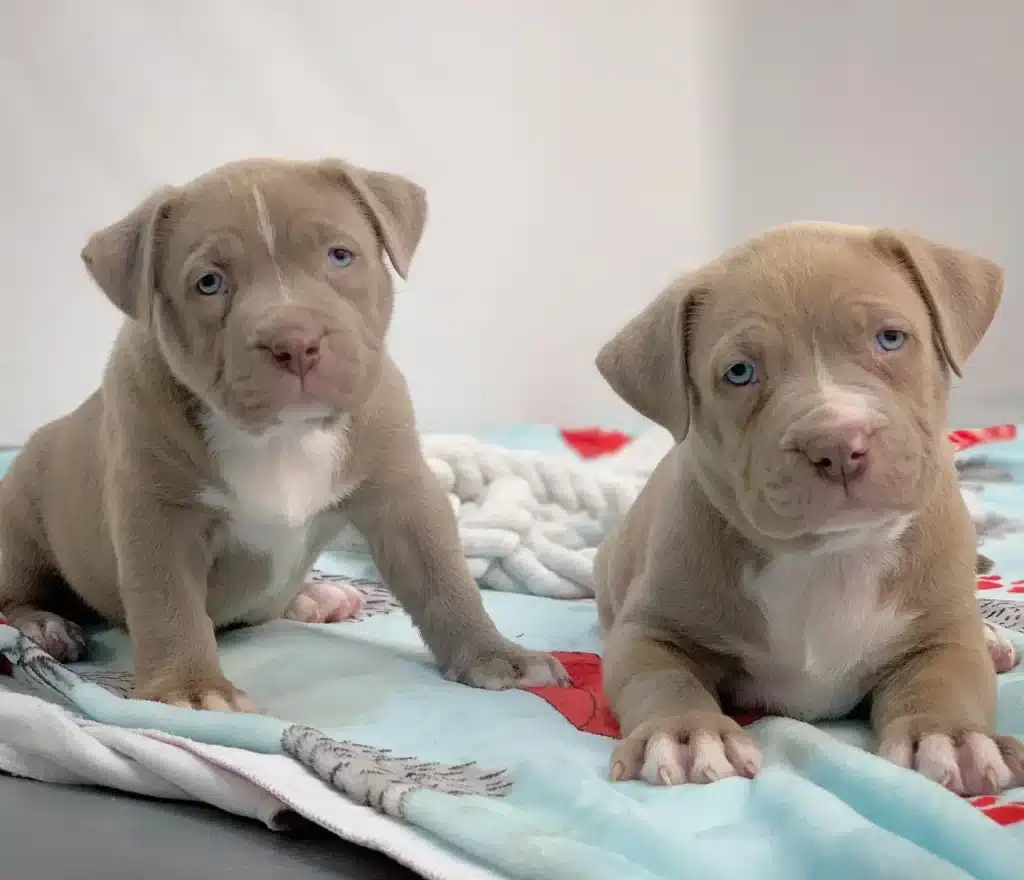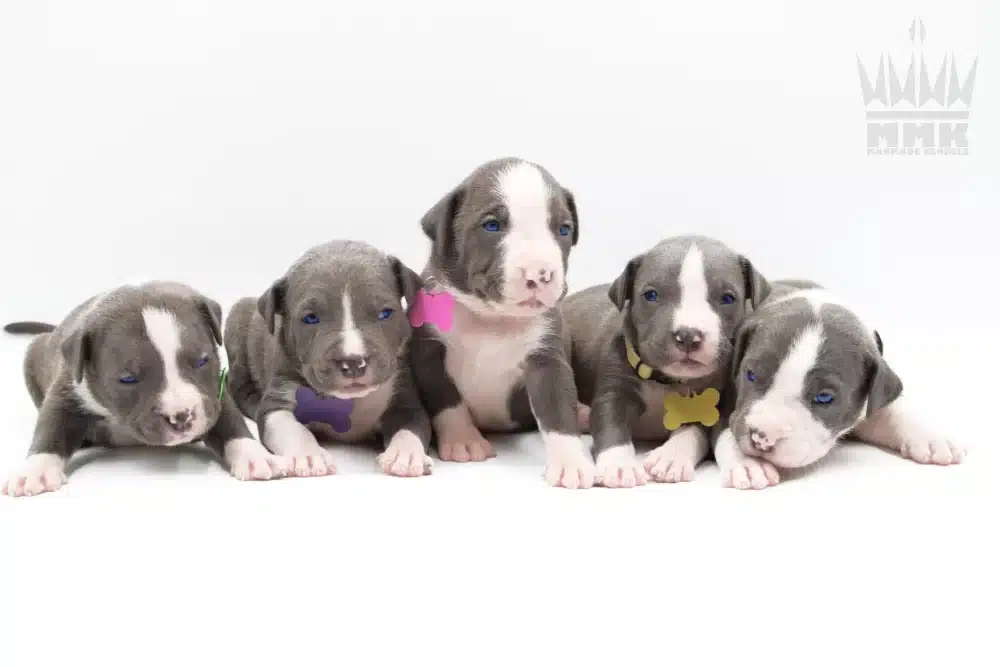You have probably seen the term ‘Pick of the Litter” or 1st Pick, 2nd Pick, or 3rd Pick used by American bully breeders when advertising their xl pitbull puppies for sale. If you have always wondered what these selections mean, we are here to help you out.
When purchasing Pitbull puppies, the term “pick of the litter” holds a significant place in the decision-making process. It’s more than just selecting a cute companion; rather, it involves a careful evaluation of various factors that determine a pitbull puppy’s potential. This article aims to unravel the complexities surrounding the concept of “pick” and guide prospective Pitbull owners in making informed decisions.
What is “Pick of the Litter” in the Pitbull Puppy Buying Process?

When we talk about the ’pick of the litter’ for the pitbull breeder, we are referring to the right to choose the first puppy from a litter. It is a valuable privilege granted to an xl pitbull breeder, usually in exchange for a stud service. The person with the first pick gets the opportunity to select the puppy they believe has the greatest potential, whether it’s for show purposes or to continue their breeding program.
When breeders refer to “pick,” they are essentially categorizing puppies within a litter based on certain criteria. This process typically involves ranking the puppies in order of preference, ranging from first pick to subsequent picks. These designations play a crucial role in determining the future trajectory of the puppy, whether it’s destined for a life as a family pet, a show dog, or even a breeding prospect.
For the potential pitbull puppy owner, pick of the litter means selecting a puppy on a first come first serve basis. The breeder will let you choose the best puppy from the litter according to your own judgement. It could be as simple as locking eyes with a puppy that seems friendly towards you and taking that puppy home.
Sometimes the xl bully breeder may help you pick the right choice for you based on their understanding of the litter and a learning a little bit about your personality. Which is why we always recommend visiting a pitbull kennels whenever possible for that first-hand interaction with both puppies and the parent dogs.
Various Picks and Their Significance
Understanding the hierarchy of picks is vital. The first pick is usually considered the cream of the crop, showcasing the most desirable traits. Second pick follows, and so on. The order is determined by factors like conformation to breed standards, temperament, and health. Each pick comes with its own set of characteristics and considerations.
Who Gets the First Pick of the Litter?
The person who gets the first pick of the litter depends on the agreements made between the breeder and third parties involved. In most cases, the breeder who owns the dam (the mother dog) has the right to possess and own the puppies. However, they may enter into contracts that allow others to have the first pick.
Breeder’s Criteria for Assigning Picks
Breeders employ a meticulous process to evaluate and assign picks. Physical characteristics, adherence to breed standards, temperament, and health assessments all play a role. Additionally, the breeder’s goals and the purpose of the puppy – whether it’s intended for the show ring, as a breeding prospect, or as a cherished family pet – influence the pick assignments.
A common arrangement is exchanging stud services for the right to the first pick of the litter. This type of contract is prevalent in the dog breeding community and can be legally enforceable. It is essential to have a written agreement specifying the terms and conditions to avoid any potential disputes.
Factors Influencing “Pick of a Litter”

Physical characteristics and conformation
When assessing physical traits, breeders look for features that align with the breed standard. This includes body structure, coat color, markings, and other breed-specific attributes. The closer a puppy aligns with these standards, the higher its pick ranking may be.
Temperament and behavior assessement
Pitbulls, known for their loyalty and affectionate nature, should also exhibit the right temperament for their intended purpose. For example, a show dog may need to display confidence and charisma, while a family pet should have a gentle and sociable demeanor.
Health evaluations and genetic considerations
The overall health of a puppy is paramount. Breeders conduct health evaluations to identify potential genetic issues or hereditary conditions. Responsible breeders aim to produce healthy litters, and this commitment to the puppy’s well-being significantly influences pick assignments.
Purpose of the puppy
The intended purpose of a Pitbull puppy plays a pivotal role in pick assignments. If the goal is to produce future generations of show dogs or breeding prospects, the breeder may prioritize certain traits. Conversely, a family pet may be selected based on its suitability for a loving home environment.
What to Look For in a Pick of the Litter?
When selecting the first pick of the litter, it’s crucial to have a clear understanding of the breed standards and the qualities you are looking for. A professional breeder will have a trained eye to identify puppies with potential and those that have disqualifying traits.
While it is challenging to predict how a puppy will look when fully grown, experienced breeders can make informed decisions based on their knowledge of the breed’s characteristics. They will consider factors such as the puppy’s physical appearance, temperament, and overall health. Additionally, breeders will look for puppies that closely adhere to the breed standards and show potential for future success in competitions or as breeding stock.
It’s important to approach the selection process objectively rather than emotionally. Have a plan and know what you are looking for, so you can choose the pick of the litter based on qualities that align with your breeding goals.
At What Age Do I Choose the Pick of the Litter?
The best age to choose the pick of the litter varies depending on the breed and the specific characteristics you are evaluating. Some breeders prefer to make the selection within the first month, while others wait until the puppies are six to eight weeks old.
Puppies undergo significant changes in their appearance and development during these early weeks. Their noses may change color, spots may appear, and their limbs may mature. It is essential to consider these factors when making your decision.
While it can be tempting to make an early selection, keep in mind that puppies need time to grow and develop. Waiting until they are a few weeks old gives you a better idea of their potential as they start to exhibit more distinct physical and behavioral traits.
Are Males or Females Better as Pick of the Litter?
The decision of choosing a male or female puppy as the pick of the litter depends on the individual breeder’s needs and goals. There is no definitive answer as to whether one gender is better than the other.
Historically, male dogs have won more Best in Show awards than females. However, this discrepancy can be attributed to various factors, such as bitches being unable to show during heat or being occupied with whelping and raising puppies. It’s important to consider the specific circumstances and requirements of your breeding program when making this decision.
Ultimately, the selection should be based on the individual puppy’s qualities and how well they align with your breeding goals. Both males and females can excel in different areas, so it’s crucial to evaluate each puppy’s potential on a case-by-case basis.
Pitfalls to avoid in the “Pick” Process
A. Recognizing Potential Red Flags in the Selection Process
While reputable breeders prioritize the health and welfare of their dogs, it’s essential for buyers to be aware of potential red flags. These may include a lack of transparency about health records, limited interaction with the puppies, or reluctance on the part of the breeder to answer questions. Exercise caution and trust your instincts.
B. Understanding the Difference Between Marketing and Substance
In the world of dog breeding, marketing can sometimes overshadow substance. Be wary of breeders who prioritize flashy marketing tactics over the well-being and quality of their puppies. Substance, including health, temperament, and adherence to breed standards, should be the primary focus.
C. Seeking References and Reviews from Previous Buyers
One of the most reliable ways to assess a breeder’s credibility is by seeking references and reviews from previous buyers. A reputable breeder will have satisfied customers willing to share their experiences. Contacting these references can provide valuable insights into the breeder’s practices and the quality of their puppies.
Should I Pick the Runt?
When considering the pick of the litter, it’s generally advised not to choose the runt. The runt is the smallest puppy in the litter and is often more vulnerable to congenital or developmental problems compared to its litter mates.
While runts may have their own unique appeal and can grow into healthy adult dogs with proper care, they are generally not the ideal choice for breeding or show purposes. Breeders typically look for puppies that exhibit the best qualities and conform to the breed standards, which the runt may not fulfill.
However, there may be exceptions to this general rule. If the runt is the only puppy without any disqualifying traits and possesses a specific characteristic that aligns with your breeding goals, it may be a viable option. Additionally, some breeders may offer incentives for taking the runt, making it a more attractive choice.
Conclusion
The first pick of the litter is a highly sought-after privilege in the world of dog breeding. It grants breeders the opportunity to select a puppy with the highest potential for success in competitions or as breeding stock. When choosing the pick of the litter, it’s essential to have a clear understanding of breed standards, evaluate puppies objectively, and consider the long-term goals of your breeding program.
Whether you decide to choose the cutest pup or focus on specific traits that align with your breeding goals, the first pick of the litter holds immense value. It’s a chance to shape the future of your breeding program and contribute positively to the breed. So, take your time, evaluate each puppy carefully, and make an informed decision that aligns with your vision as a responsible dog breeder.
Remember, the first pick of the litter is not just about selecting a puppy; it’s about investing in the future of the breed and fulfilling your passion for responsible dog breeding.
I am a highly skilled content writer and SEO expert with a passion for helping small businesses succeed in the digital world. With my extensive knowledge of the latest SEO techniques and strategies, I have successfully assisted numerous clients in improving their website rankings, generating more leads, and driving a significant increase in website traffic.
As a professional content writer and SEO expert, I am confident in my ability to contribute significantly to the success of small businesses. If you are seeking a results-driven, highly skilled digital marketer who can help you increase your ranking, convert new leads, and see a substantial improvement in website traffic, I would welcome the opportunity to collaborate with you.
Website: https://manmadewebsites.com/
Email: hello@digitalmarketingchap.com

